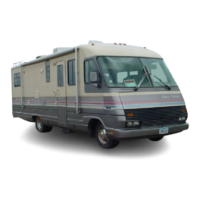39
Discovery, Discovery LXE, Pace Arrow, and Pace Arrow LXEt
020161c
WARNING:
A slow leak may go
unnoticed on one of the
dual tires. Damage to the
other tire can occur tire
from weight overload. Tires
with damaged sidewalls can
burst upon inflation. A flat
or nearly flat tire can also
generate enough heat from
friction to ignite.
WARNING:
For safety purposes, clear
the area of people and
pets during tire inflation.
Inflate tires using a remote
inflation device.
Air Pressure Checklist
When checking ination
pressure, conrm the tires
are cool before increasing
or decreasing ination
pressure. Tires in direct
sunlight will increase
ination pressure. Driving
a short distance will heat
the tires and raise ination
pressure.
NOTE:
It is normal for tires to
heat up and inflation
pressure to increase during
travel. If the motorhome
must be driven to get air,
check and record the tire
pressure first then add the
proportional amount of
pressure so when the tires
cool, inflation pressure will
be correct.
Remove the cap from the
valve stem.
Firmly press the tire gauge
onto the valve stem and
record reading.
Add air to achieve
recommended ination
pressure.
If the tire is overinated,
release air by pushing on
the metal stem in the center
of the valve then recheck
the pressure.
Replace the valve stem cap.
Repeat with each tire.
Inspect all the tires for nails
or other objects that could
be embedded or puncture
the tire and cause a leak.
Check the sidewalls for
gouges, cuts, bulges, or
other irregularities.
NOTE:
Air pressure in a tire
increases (warm weather)
or decreases (cold weather)
one to two pounds for
every 10° F. of temperature
change.

